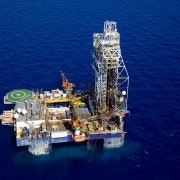For local gas, an idea worth floating
Australia is losing the competitiveness battle in gas despite its abundant reserves. Innovation is required to narrow the gap and reap the rewards, and floating LNG could be the answer.
The Conversation
Governments and the energy sector are faced with the competing demands of increasing energy requirements of an increasingly wealthy population and the environmental need to mitigate carbon emissions.
Anne Pickard, Shell's Country Chair for Australia, noted in her plenary address at the recent Deep Offshore Technology Conference in Perth, that the challenge facing the energy sector is that the world's population is expected to rise to eight billion by 2030, up from seven billion today, and that GDP per capita is expected to triple by 2030 in India and China – putting around 2.5 billion people higher up the energy ladder.
Gas is the cleanest burning fossil fuel and it is abundant. Identified reserves are estimated at around 250 years' supply at current consumption rates, and may be as much as 30 per cent higher if the reserves in the Arctic are included. Gas is a practical and achievable way to meet increasing energy demand with reduced CO2 emissions relative to other fossil fuels. In contrast, renewables meet only 13 per cent of the current total energy demand and remain costly to upscale relative to gas.
Australia has numerous gas mega-projects currently under construction or in planning. Offshore Western Australia, these include the Woodside-operated Pluto, Browse and Sunrise projects and the Chevron-operated Gorgon and Wheatstone projects. These mega-projects could triple Australia's current LNG production, providing Australia with the opportunity to rival Qatar as the world's largest LNG exporter by 2020. Australia also has very significant "stranded gas” resources which are discoveries in more remote locations, further offshore, often with smaller reservoirs.
However, Australia must remain competitive and currently Australian LNG is expensive. Pickard noted that it costs around 20 per cent more to deliver Australian LNG to Japan than LNG from the United States and Canada, which are emerging as competitors in the export market. Pickard put the high Australian cost down to high production costs, heavy regulation and the high Australian dollar and noted that for Australia to remain competitive in the offshore energy sector, innovation is essential.
One technology that may help to push Australian gas down the cost curve, and unlock our stranded gas, is floating LNG.
FLNG is undoubtedly innovative, requiring revolutionary technology to solve a jigsaw of technical and execution challenges. Challenges include encapsulating processing and production facilities, personnel accommodation, storage and offloading on a single floating structure, which is moored in deep water in potentially cyclonic conditions in a safe, efficient and operable manner. The combination of these technical challenges is unprecedented at the required scale – and the scale is massive.
Shell's Prelude project in offshore Western Australia is likely to be the world's first FLNG facility. The $12 billion project received the final investment decision in May 2011 with expected first gas in 2016. The Prelude facility will comprise a ship-shape hull with deck and top sides – 488m long and 74m wide – long enough for six A380 airliners to park nose-to-tail.
In addition to economic benefits, FLNG provides green benefits over and above those of conventional offshore LNG that involves transport pipelines to shore (which may be several hundred kilometres away) and an onshore processing facility. Construction materials and seabed and land disturbance is therefore greatly reduced with FLNG. Developing the gas at the location of the gas field also reduces impact on sensitive coastal habitats as FLNG avoids the need for shoreline pipe crossings, dredging and jetty works.
Opportunities for FLNG are not limited to offshore Western Australia. Global opportunities exist for development of previously considered stranded gas – not just in areas that are currently too remote or fields that are too small to be economical to develop with existing technology – but also in regions where security issues preclude onshore processing. Other operators, including Total and Statoil, are actively pursuing FLNG technology to add to their energy portfolios. Petronas, the national oil company of Malaysia, passed FID for a FLNG project in June this year.
FLNG provides an opportunity for economically accessing large reserves from offshore fields previously considered stranded gas. In some situations, FLNG appears cheaper per tonne to build and with a lighter environmental footprint than conventional LNG and other fossil fuel energy sources.
It is critical for Australia to reduce costs in order to stay competitive in the global energy sector – more so with increasing, cheaper gas production in Russia, Canada and the US.
The bottom line is that much stranded gas offshore in Western Australia and elsewhere is not commercially viable with current technology and it is unlikely that it could be developed in the near future without FLNG. Non-development of these fields prevents that gas feeding into our energy mix. It is also associated in dollar terms with considerable loss to a nation's GDP, tax revenue, spending on goods and services and local jobs over the lifetime of the project as well as future financial and competitive losses arising from stepping off the technology ladder.
Susan Gourvenec is a professor of offshore geomechanics at the University of Western Australia. This story was first published on The Conversation. Republished with permission.
Governments and the energy sector are faced with the competing demands of increasing energy requirements of an increasingly wealthy population and the environmental need to mitigate carbon emissions.
Anne Pickard, Shell's Country Chair for Australia, noted in her plenary address at the recent Deep Offshore Technology Conference in Perth, that the challenge facing the energy sector is that the world's population is expected to rise to eight billion by 2030, up from seven billion today, and that GDP per capita is expected to triple by 2030 in India and China – putting around 2.5 billion people higher up the energy ladder.
Gas is the cleanest burning fossil fuel and it is abundant. Identified reserves are estimated at around 250 years' supply at current consumption rates, and may be as much as 30 per cent higher if the reserves in the Arctic are included. Gas is a practical and achievable way to meet increasing energy demand with reduced CO2 emissions relative to other fossil fuels. In contrast, renewables meet only 13 per cent of the current total energy demand and remain costly to upscale relative to gas.
Australia has numerous gas mega-projects currently under construction or in planning. Offshore Western Australia, these include the Woodside-operated Pluto, Browse and Sunrise projects and the Chevron-operated Gorgon and Wheatstone projects. These mega-projects could triple Australia's current LNG production, providing Australia with the opportunity to rival Qatar as the world's largest LNG exporter by 2020. Australia also has very significant "stranded gas” resources which are discoveries in more remote locations, further offshore, often with smaller reservoirs.
However, Australia must remain competitive and currently Australian LNG is expensive. Pickard noted that it costs around 20 per cent more to deliver Australian LNG to Japan than LNG from the United States and Canada, which are emerging as competitors in the export market. Pickard put the high Australian cost down to high production costs, heavy regulation and the high Australian dollar and noted that for Australia to remain competitive in the offshore energy sector, innovation is essential.
One technology that may help to push Australian gas down the cost curve, and unlock our stranded gas, is floating LNG.
FLNG is undoubtedly innovative, requiring revolutionary technology to solve a jigsaw of technical and execution challenges. Challenges include encapsulating processing and production facilities, personnel accommodation, storage and offloading on a single floating structure, which is moored in deep water in potentially cyclonic conditions in a safe, efficient and operable manner. The combination of these technical challenges is unprecedented at the required scale – and the scale is massive.
Shell's Prelude project in offshore Western Australia is likely to be the world's first FLNG facility. The $12 billion project received the final investment decision in May 2011 with expected first gas in 2016. The Prelude facility will comprise a ship-shape hull with deck and top sides – 488m long and 74m wide – long enough for six A380 airliners to park nose-to-tail.
In addition to economic benefits, FLNG provides green benefits over and above those of conventional offshore LNG that involves transport pipelines to shore (which may be several hundred kilometres away) and an onshore processing facility. Construction materials and seabed and land disturbance is therefore greatly reduced with FLNG. Developing the gas at the location of the gas field also reduces impact on sensitive coastal habitats as FLNG avoids the need for shoreline pipe crossings, dredging and jetty works.
Opportunities for FLNG are not limited to offshore Western Australia. Global opportunities exist for development of previously considered stranded gas – not just in areas that are currently too remote or fields that are too small to be economical to develop with existing technology – but also in regions where security issues preclude onshore processing. Other operators, including Total and Statoil, are actively pursuing FLNG technology to add to their energy portfolios. Petronas, the national oil company of Malaysia, passed FID for a FLNG project in June this year.
FLNG provides an opportunity for economically accessing large reserves from offshore fields previously considered stranded gas. In some situations, FLNG appears cheaper per tonne to build and with a lighter environmental footprint than conventional LNG and other fossil fuel energy sources.
It is critical for Australia to reduce costs in order to stay competitive in the global energy sector – more so with increasing, cheaper gas production in Russia, Canada and the US.
The bottom line is that much stranded gas offshore in Western Australia and elsewhere is not commercially viable with current technology and it is unlikely that it could be developed in the near future without FLNG. Non-development of these fields prevents that gas feeding into our energy mix. It is also associated in dollar terms with considerable loss to a nation's GDP, tax revenue, spending on goods and services and local jobs over the lifetime of the project as well as future financial and competitive losses arising from stepping off the technology ladder.
Susan Gourvenec is a professor of offshore geomechanics at the University of Western Australia. This story was first published on The Conversation. Republished with permission.
Share this article and show your support















